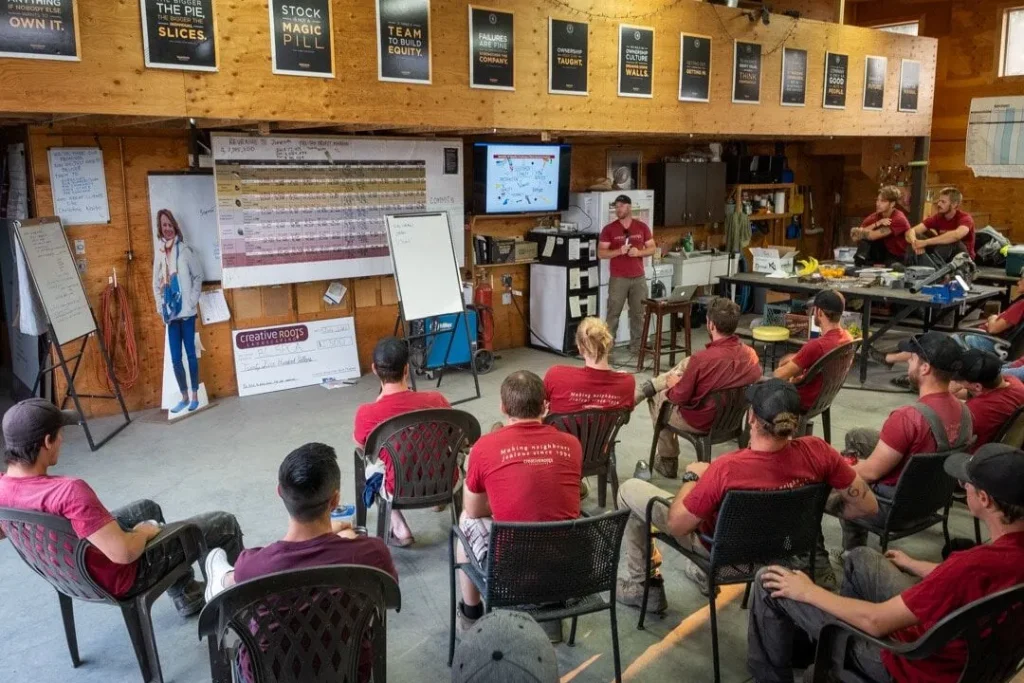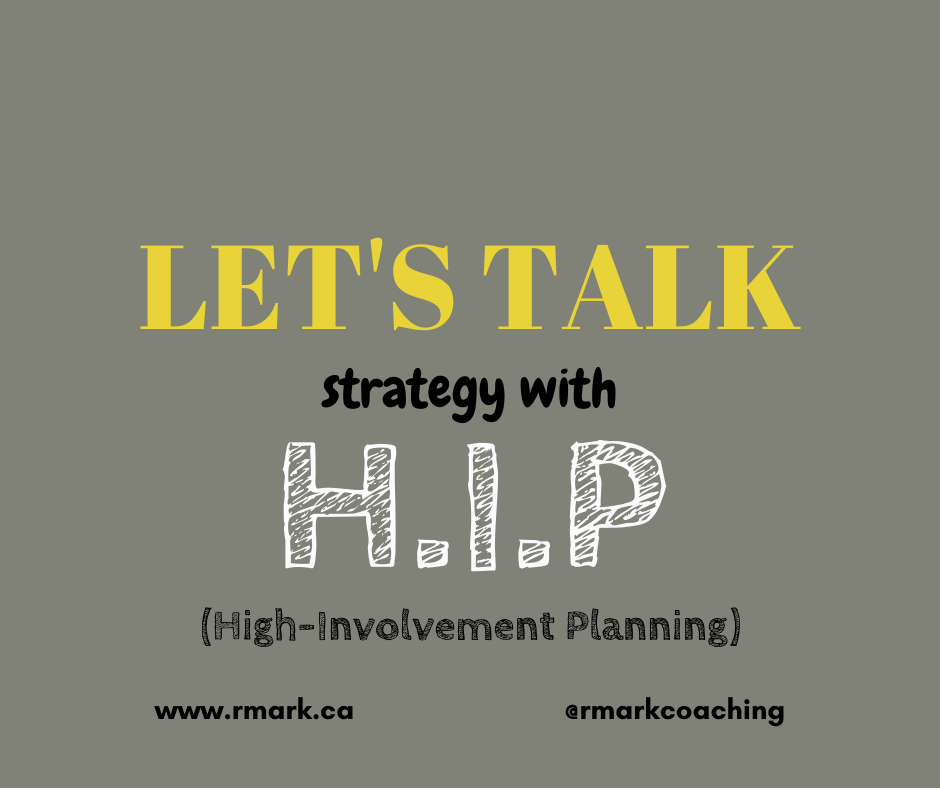Up until about 14 years ago when I first started to think about strategic planning around business operations at Creative Roots Landscaping, I had the idea that they were typically only divided into the front-end and back-end tasks that you and your team believe are a priority and must be performed in order to work towards the company’s objectives. Actually, it was more about me sitting down, deciding what I wanted to do during the upcoming year and then “telling” the staff the way it was going to be. I made the plan and decided how we would accomplish that plan without any input from my employees.
The reality was that I didn’t know what to do when it came to working on the business in a manner that gave the people within it a reason to be fully engaged.
When my good friend and mentor suggested I look into Open Book Management I took his advice and had my “aha” moment. (That is a whole other story in itself which you can read here.) I committed to the process, and have been learning everything I possibly can from the nearly four decades SRC (the pioneers of Open Book Management) has spent perfecting its approach to strategic planning, and every year I like to think we keep getting better by following their example. Here’s a peek into our step-by-step approach to building good, accurate plans employees love to execute.
Think about it in the context of having kids who are picky eaters. Getting them involved in making meals, choosing healthy snacks and even letting them name the meals they help create, gives them a sense of ownership and participation. When you’re proud of what you’ve helped create, it tastes a whole lot better.
People support what they help to create. That is why at SRC and The Great Game of Business®, building a strategic plan is about involving ALL employees in the planning process. Planning is a year-round event, and it begins with what’s happening in the real world. For our team at Creative Roots this is so we can accomplish two goals:
- Develop business-growth plans they can own.
- Help employees answer the questions: Are we confident and energized about the direction of the company?
Don’t get me wrong…having a strategic plan is more than putting on paper what you plan on doing over the next year. How are you going to get there? What is the strategy? What does your plan look like? What is happening in the market that could impact the business? Most importantly, you need to enable EVERYBODY to contribute. This is what is referred to in The Great Game of Business as High-Involvement Planning™.
1. Share your winning aspirations.
So much has changed in the last two years, and the next-gen workforce wants to be part of something bigger than themselves. They need the why behind the how – maybe more than any other workforce in history. Sharing what your winning aspirations are is the foundation to building a great strategy. If you’re an NHL team starting your season, you have one goal in mind: Win the Stanley Cup. This type of winning aspiration sets the tone, context, and inspiration for everything that follows. As Jack Stack, the father of open-book management, says, “When you show people the Big Picture, you define winning.”
2. Review your strategy.
Strategies are like opinions…everybody has one. The question … is yours the right one?
Is it a strategy that:
- Will get you to where you want to go?
- Provides a sustainable competitive advantage and superior value?
- Everyone understands, believes in, and is committed to achieving?
To have a viable strategy for growth, you must dive into the right actions to ensure your success. You start by understanding the drivers that will more than likely impact your industry. Then make a plan on how you will compete and, most importantly, how you will make money. Your strategy must also take into account your target customer, how you will position yourself in the market and deliver your product or service in a way that makes you different from your competitors. All this will give you permission to say “Yes” to winning strategies and say “No” to the strategies that do not fit this scenario.
3. Identify your growth & “what-if” contingencies
The best-laid plans of mice and men often go awry
No matter how carefully you plan, something may still go wrong with it.
Being proactive versus REACTIVE ensures short and long-term success by answering those “what-ifs” in your business.
- What if … the assumptions we make are wrong?
- What if … our largest customer moves or downsizes?
- What if … our competitors start luring our customers away?
- What if … our business gets hit with another Black Swan, like COVID-19?
- What if?… What if?… What if?…
At Creative Roots, we consider a contingency to be a product or service that we’ve collaborated on and had success with in the past, is cost-effective and can be implemented on short notice. Don’t limit yourself to coming up with new products and services, but instead expanding a current service, offering add-ons, etc.
The important part is to have the groundwork in place to activate quickly.
4. Know your marketplace.
According to The Great Game of Business, “a business that doesn’t know its market is a business that is destined to fail.” No team goes into a game without having a deep understanding of where you’re playing and who your competition is. If you don’t have this understanding, how can you expect to win? Your company needs to be market-driven, customer focussed and be keenly aware of who your competitors are. That is how your team will have the edge over what the competition is doing … and NOT doing.
5. Establish your strategic priorities.
These are the key priorities – or plays – that represent both long-term and short-term choices that give you the best opportunity to win. These priorities should cover THREE opportunities:
- A sustainable competitive advantage.
- Superior financial returns.
- Superior value.
6. Build your sales plan.
Without sales…products, services, etc….there is no business. It is the very first line on the Income Statement, so this is where we start. Your sales plan should be based in reality and with the goal of team alignment and buy-in. By educating, informing, and involving the team in what we know about the marketplace, how we plan to win, and how we are performing, we can all align on one singular goal, the Critical Number™.
A fully developed sales and marketing plan is market-driven, performance-based, performance-focused, and fully supported.
- Market Driven: If you are going to state a goal, it must be based on what the true market potential is, not some “pie-in-the-sky” number. Taking the time to do a market analysis will give you the information you need to develop a believable, predictable sales plan for your annual (short-term) and long-term plans.
- Performance-based: To plan where you’re going, you need to look at where you’ve been. Taking a look at five years’ worth of historical financials provides valuable insight into trends and cycles that may affect your sales and marketing strategy moving forward.
- Performance-focused: Your sales and marketing strategy should support achieving your growth strategy for Growth, short-term (annual plan) and long-term (5-year plan). Don’t forget about the contingency planning that will help the team in dealing with those “what-if” scenarios that might pop up.
- Fully Supported: Did you involve the entire company in creating the sales plan? Do all the players support the plan? By getting everyone’s buy-in, you can harness the full potential of the business: people, brainpower and finances.
7. Ensure confidence in the plan.
Okay, so now you’ve built the plan and your goal is to now get buy-in. Remember, people support what they help to create. As Jack Stack says, “The way you produce the plan is just as important as the plan itself … To get ownership and ensure results, you must focus on how your plans are created and how people are involved in the process.” This was a major pain point for us in the early days of the company before Open Book Management. If people don’t participate, they don’t buy in. If they don’t buy in, they don’t commit. If they don’t commit, they don’t deliver. It’s a shift in the mindset from “what’s your plan” to “this is our plan.”
Don’t wait until step 10 to get your employees involved! Present the plan that you all created and see how confident your team is in the plan. Checking in on the progress through regular Huddles is key to the success of your plan.
8. Build your financial plan.
I loved playing sports in high school. I learned that teams worked well together on a common goal – winning the game – when we could all track our successes and failures in real-time. It just took some time for me to understand how I could apply that lesson to my business.
Here’s what I mean:
It’s coming up to halftime and you’re up or down by a few points. Everyone on the court or pitch has already agreed on what will define a win and knows the score because it is stated clearly on the “jumbotron.”
This is the opportunity to ramp up their game…to preserve the lead or get it back and they, in either instance, will have to work as a team to pull it off.
A financial scoreboard has the same effect. But business owners, for many different reasons, are often nervous about sharing “the score” in the game of their business. And they’re missing out on an opportunity. From Departmental to Company-wide financial and non-financial scoreboards, we are sure to define and track the metrics that are critical to achieving what we are trying to achieve.
A good scoreboard requires some effort to build and maintain. And it takes some humility to own up to mistakes made – either in administration, quoting on jobs or onsite hiccups that either weren’t anticipated or managed well. But an accurate scoreboard will reflect the actual score in the game. Everyone has a chance to learn and decide how to advance the goals of the company.
9. Build your people plan.
Over the years, we hired many “right” people who did excellent work. The problem was we were consistent when it came to attracting and keeping both the right and wrong people, and that was a problem we had to own.
Without the people to execute the marketing plan, sales plan, or financial plan, you will be dead in the water.

What you call them is not essential. It can be an “A Player,” a “Rockstar,” the “Right Person,” or whatever works. What is important is the definition of what that means. For the sake of getting on the same page, let’s see if the following description given by Gino Wickman in his well-written book, Traction, helps us agree on this “Right Person Statement.“
“The right people are the ones who share your company’s core values. They fit and thrive in your culture. They are people you enjoy being around and make your organization a better place to be.”
Your company’s vision is a powerful tool for attracting and hiring like-minded people. Sharing the business’s why – its mission – and the long-term vision will also get people excited about coming aboard and contributing to the journey.
10. Execute with The Game
Real estate might be about location, location, location, but your strategic plan is all about executing, executing, executing. It’s fair to say that the planning is not always simple. However, it can be easy to execute and maintain when you share the load across your entire workforce. I sound like a broken record … I know … just remember that people support what they help to create. So let them help you. Let them help you create the plan, then help you in executing that plan. The Game becomes exciting for those involved instead of a job they were told to do.




